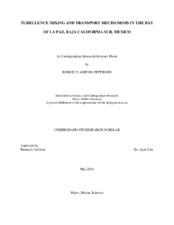| dc.description.abstract | ABSTRACT
Turbulence Mixing and Transport Mechanisms in a Coastal Ecosystem: Bay of La Paz, Baja California Sur, Mexico. (May 2014)
Burkely Ashton Pettijohn
Department of Marine Sciences
Texas A&M University
Research Advisor: Dr. Ayal Anis
Department of Marine Sciences
Turbulence is a major mechanism for transport of waterborne constituents such as nutrients, pollutants, and sediments, thus, directly controlling sustainability of marine ecosystems. Turbulence activity and its control mechanisms are poorly understood, and measurement of turbulence intensities has proven to be a cumbersome task. To more clearly understand these physical processes, a suite of sensors were deployed in a threatened bay (La Paz, Mexico): conductivity, temperature, and depth sensors (CTDs) on a tight mooring line (allowing the construction of density profiles), alongside current profilers, and a free-falling turbulence profiler. Turbulence activity was examined, as well as the contributions to particle transport and mixing. Furthermore, relationships between Thorpe displacements, TL, and dissipation rates of turbulence kinetic energy, ε, were explored. This will assist in allowing ε (an indicator of turbulence intensities) to be estimated indirectly from more common and affordable measurement methods. The data show a clear tidal influence on internal waves and the physical properties of the water, and tides strongly influence turbulence events. Because tides and topography are fundamental to the creation of internal waves, the topography of the bay is vital to the production of turbulence. Moreover, the relationship between TL and ε shows influence by the gradient Richardson number, Ri. Where large values of Ri tend to not support larger values of TL, and is defined as a nonlinear relationship in the form of:
ε = N^3 * .026TL ^ 1.019; where N is the buoyancy frequency. | en |


